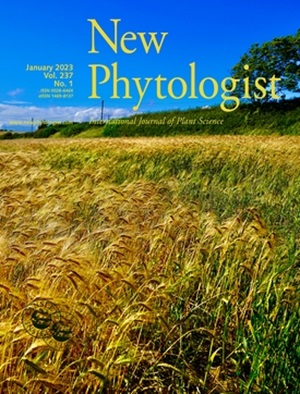深入了解热带高地树木茎中甲烷、氧化亚氮和二氧化碳通量的亚日变化
IF 8.3
1区 生物学
Q1 PLANT SCIENCES
引用次数: 0
摘要
最近的研究表明,尽管树木之间的茎通量变化很大,但在一些森林中,茎通量可以改变甲烷(CH4)汇或氧化亚氮(N2O)源的强度,但这些通量的模式和大小仍不清楚。本研究探讨了茎秆和土壤CH4、N2O和二氧化碳(CO2)通量亚日和季节变化的驱动因素。在热带高原森林中,利用自动室内系统连续19个月测量了两种树种(Eperua falcata (Aubl.)和Lecythis poiteaui (O. Berg))的单株茎及其周围土壤的CH4、N2O和CO2通量。这些通量的亚日变化与不同土壤水分条件下的环境和茎生理(液流和茎直径变化)测量有关。结果表明,生理和气候因素只能部分解释亚日通量的变化。茎秆CH4和CO2排放和N2O吸收随土壤含水量、时间和个体而变化。茎通量与土壤通量解耦。我们的研究有助于理解干旱温室气体通量的调控。这表明,其他变量(如内部气体浓度、木材定殖微生物、木材密度和解剖结构)可能解释了树干通量中剩余的无法解释的变异,突出表明需要进一步研究。本文章由计算机程序翻译,如有差异,请以英文原文为准。
Insights into the subdaily variations in methane, nitrous oxide and carbon dioxide fluxes from upland tropical tree stems
Summary Recent studies have shown that stem fluxes, although highly variable among trees, can alter the strength of the methane (CH4 ) sink or nitrous oxide (N2 O) source in some forests, but the patterns and magnitudes of these fluxes remain unclear. This study investigated the drivers of subdaily and seasonal variations in stem and soil CH4 , N2 O and carbon dioxide (CO2 ) fluxes. CH4 , N2 O and CO2 fluxes were measured continuously for 19 months in individual stems of two tree species, Eperua falcata (Aubl.) and Lecythis poiteaui (O. Berg), and surrounding soils using an automated chamber system in an upland tropical forest. Subdaily variations in these fluxes were related to environmental and stem physiological (sap flow and stem diameter variations) measurements under contrasting soil water conditions. The results showed that physiological and climatic drivers only partially explained the subdaily flux variations. Stem CH4 and CO2 emissions and N2 O uptake varied with soil water content, time of day and between individuals. Stem fluxes decoupled from soil fluxes. Our study contributes to understanding the regulation of stem greenhouse gas fluxes. It suggests that additional variables (e.g. internal gas concentrations, wood‐colonising microorganisms, wood density and anatomy) may account for the remaining unexplained variability in stem fluxes, highlighting the need for further studies.
求助全文
通过发布文献求助,成功后即可免费获取论文全文。
去求助
来源期刊

New Phytologist
生物-植物科学
自引率
5.30%
发文量
728
期刊介绍:
New Phytologist is an international electronic journal published 24 times a year. It is owned by the New Phytologist Foundation, a non-profit-making charitable organization dedicated to promoting plant science. The journal publishes excellent, novel, rigorous, and timely research and scholarship in plant science and its applications. The articles cover topics in five sections: Physiology & Development, Environment, Interaction, Evolution, and Transformative Plant Biotechnology. These sections encompass intracellular processes, global environmental change, and encourage cross-disciplinary approaches. The journal recognizes the use of techniques from molecular and cell biology, functional genomics, modeling, and system-based approaches in plant science. Abstracting and Indexing Information for New Phytologist includes Academic Search, AgBiotech News & Information, Agroforestry Abstracts, Biochemistry & Biophysics Citation Index, Botanical Pesticides, CAB Abstracts®, Environment Index, Global Health, and Plant Breeding Abstracts, and others.
 求助内容:
求助内容: 应助结果提醒方式:
应助结果提醒方式:


